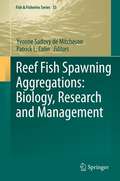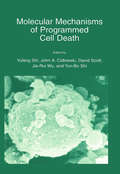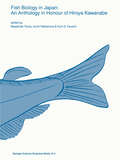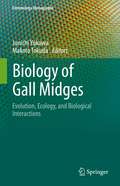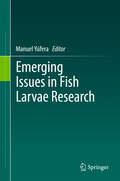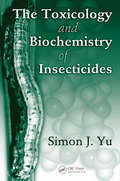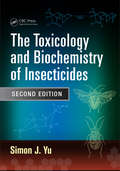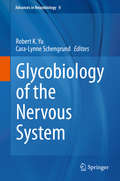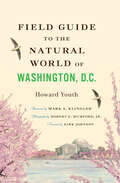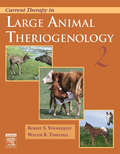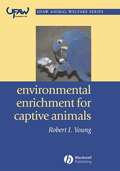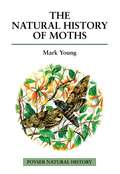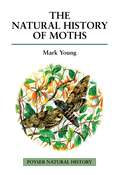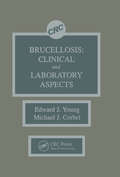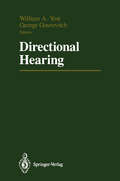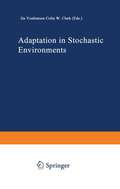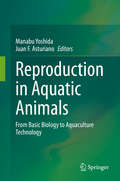- Table View
- List View
Reef Fish Spawning Aggregations: Biology, Research and Management (Fish & Fisheries Series #35)
by Yvonne Sadovy Sadovy de Mitcheson and Patrick L. L. ColinReef fish spawning aggregations, ranging from small groups to many tens of thousands of individuals, are spectacular but poorly known natural phenomena whereby fish assemble at specific times and locations to spawn. For some species these large groups may be the only form of reproduction, the high fish numbers briefly giving a false impression of stability and abundance—an ‘illusion of plenty’. They are often a focus for intensive seasonal fishing because of their predictability and because many important commercial fishes form them. Highly vulnerable to overexploitation, many aggregations and their associated fisheries, have disappeared or are in decline. Few are effectively managed or incorporated into protected areas. Aggregations are not well understood by fishery scientists, managers and conservationists and their significance little appreciated by fishers or the wider public. To ensure their persistence to replenish important fisheries in coral ecosystems, maintain their ecosystem function and continue to delight divers, a significant change in perspective is needed to foster protection and management. This book provides comprehensive and practical coverage of the biology, study and management of reef fish aggregations, exploring their how, when, where, and why. It explores ways to better protect, study, manage and conserve them, while identifying key data gaps and questions. The text is extensively illustrated with many unique, never before published, photographs and graphics. Case studies on over 20 interesting and important fishes are included, outlining their biology and fisheries and highlighting major concerns and challenges.
Molecular Mechanisms of Programmed Cell Death
by Yun-BoShi Jia-RuiWu DavidScott John A. Cidlowski YufangShiThe 2002 Nobel Prize in Physiology or Medicine was awarded to Sydney Brenner, H. Robert Horvitz, and John E. Sulston for their seminal discoveries concerning "genetic regulation of organ development and programmed cell death." This clearly marked the prime importance of understanding the molecular mechanisms controlling cell death. The 1 st International Symposium on Programmed Cell Death was held in the Shanghai Science Center of the Chinese Academy of Sciences on September 8-12, 1996. A number of key issues in apoptosis were discussed at the meeting, and progress in major areas of apopto sis research was summarized by expert participants at the meeting and published by Plenum Publishing Corporation as a book entitled Programmed Cell Death. In the last six years, we have witnessed a real explosion in our knowledge on how cells undergo apoptosis, thereby participating in various developmental and pathophysiological processes. At this ever exciting time, we organized the 2nd International Symposium on Programmed Cell Death.
Fish biology in Japan: an anthology in honour of Hiroya Kawanabe (Developments in Environmental Biology of Fishes #18)
by Masahide Yuma Izumi Nakamura Kurt D. FauschFish biology in Japan: an anthology in honour of Hiroya Kawanabe (Developments in Environmental Biology of Fishes #18)
by Masahide Yuma Izumi Nakamura Kurt D. FauschBiology of Gall Midges: Evolution, Ecology, and Biological Interactions (Entomology Monographs)
by Junichi Yukawa Makoto TokudaThis book provides practical ecological, ethological, evolutionary, and biogeographic data for gall-inducing cecidomyiids, their galls and host plants, based on field surveys, laboratory experiments and genetic analysis. It refers to various researches on gall-inducing insects published by a world of biologists. Practical methods of field surveys and data analysis are presented, as well as topics on parasitoids, invasive pests, and beneficial gall midges that would be useful for applied entomologists. Readers can learn an ecological way of thinking through diverse interrelations between insects and plants, and the analysis of ecological data from gall-inducing cecidomyiids. Galls can be easily observed in the field continuously from early to final stage of the development of galls and gall inducers because of their outstanding features and immobility. It provides important data of the host plant such as phenology, abundance as food resources, and the survival of galled organs. By taking these advantages, many biologists have used galls and gall-inducing insects as highly convenient organisms for a wide range of studies including ecology, ethology, evolution, and biogeography. The book primarily intends to present the appeal of galls and gall-inducing insects for various biological studies. In particular, gall-inducing cecidomyiids are ideal insects to study ecology and evolution. It helps to open the doors to further cryptic study subjects. Also, integrating various ecological, ethological, evolutionary and biogeographic data as shown in this book can serve to further advance the macroevolutionary studies of insects.
Emerging Issues in Fish Larvae Research
by Manuel YúferaThis book deals with the fundamentals of key physiological mechanisms involved in the development and growth of fish larvae. Chapters included show how the environmental and nutritional conditions are affecting the developmental process from its molecular basis and how these same conditions also influence the final characteristics of late larvae and fry. This volume provides recent findings on the importance of environmental rhythms, some specific nutrients and the adequate microbial environment in the developmental processes including recent results of current research projects.
The Toxicology and Biochemistry of Insecticides
by Simon J. YuThe first book in two decades to address this multi-faceted field, The Toxicology and Biochemistry of Insecticides provides the most up-to-date information on insecticide classification, formulation, mode of action, resistance, metabolism, environmental fate, and regulatory legislation. The book draws on the author's groundbreaking research
The Toxicology and Biochemistry of Insecticides
by Simon J. YuDespite their potentially adverse effects on nontarget species and the environment, insecticides remain a necessity in crop protection as well as in the reduction of insect-borne diseases. The Toxicology and Biochemistry of Insecticides provides essential insecticide knowledge required for the effective management of insect pests. Continuing as the
Glycobiology of the Nervous System (Advances in Neurobiology #9)
by Robert K. Yu Cara-Lynne SchengrundA thorough introduction is provided to the variety and complexity of the roles that glycoconjugates play in the cells of the nervous system. Basic information as well as the latest developments in neural glycobiology are discussed. Topics covered range from the structure and metabolism of the saccharide chains and current approaches used in their study, to changes glycoconjugates undergo during development and aging of the nervous system and the roles they have in neurological disease. The breadth and depth of topics covered make it an essential reference for those new to the field as well more seasoned investigators.
Field Guide to the Natural World of Washington, D.C.
by Howard YouthNature awaits discovery at almost every turn in the complex ecosystem of Washington, D.C. In parks large and small, within the District's gardens, and on public streets, there is tremendous biodiversity. In Field Guide to the Natural World of Washington, D.C., naturalist Howard Youth takes us on an urban safari, describing the wild side of the nation's capital.Beyond the abundant wildlife that can be seen in every neighborhood, Washington boasts a large park network rich in natural wonders. A hike along the trails of Rock Creek Park, one of the country’s largest and oldest urban forests, quickly reveals white-tailed deer, eastern gray squirrels, and little brown bats. Mayapples, Virginia bluebells, and red mulberry trees are but a few of the treasures found growing at the National Arboretum. A stroll along the Potomac and Anacostia Rivers might reveal stealthy denizens such as bullfrogs, largemouth bass, and common snapping turtles. Detailed drawings by Carnegie artist Mark A. Klingler and photography by Robert E. Mumford, Jr., reveal the rich color and stunning beauty of the flora and fauna awaiting every D.C. naturalist.Whether seeking a secluded jog or an adventurous outing, residents and tourists alike will find this handsome guide indispensable for finding oases away from the noise of the city.
Field Guide to the Natural World of Washington, D.C.
by Howard YouthNature awaits discovery at almost every turn in the complex ecosystem of Washington, D.C. In parks large and small, within the District's gardens, and on public streets, there is tremendous biodiversity. In Field Guide to the Natural World of Washington, D.C., naturalist Howard Youth takes us on an urban safari, describing the wild side of the nation's capital.Beyond the abundant wildlife that can be seen in every neighborhood, Washington boasts a large park network rich in natural wonders. A hike along the trails of Rock Creek Park, one of the country’s largest and oldest urban forests, quickly reveals white-tailed deer, eastern gray squirrels, and little brown bats. Mayapples, Virginia bluebells, and red mulberry trees are but a few of the treasures found growing at the National Arboretum. A stroll along the Potomac and Anacostia Rivers might reveal stealthy denizens such as bullfrogs, largemouth bass, and common snapping turtles. Detailed drawings by Carnegie artist Mark A. Klingler and photography by Robert E. Mumford, Jr., reveal the rich color and stunning beauty of the flora and fauna awaiting every D.C. naturalist.Whether seeking a secluded jog or an adventurous outing, residents and tourists alike will find this handsome guide indispensable for finding oases away from the noise of the city.
Field Guide to the Natural World of Washington, D.C.
by Howard YouthNature awaits discovery at almost every turn in the complex ecosystem of Washington, D.C. In parks large and small, within the District's gardens, and on public streets, there is tremendous biodiversity. In Field Guide to the Natural World of Washington, D.C., naturalist Howard Youth takes us on an urban safari, describing the wild side of the nation's capital.Beyond the abundant wildlife that can be seen in every neighborhood, Washington boasts a large park network rich in natural wonders. A hike along the trails of Rock Creek Park, one of the country’s largest and oldest urban forests, quickly reveals white-tailed deer, eastern gray squirrels, and little brown bats. Mayapples, Virginia bluebells, and red mulberry trees are but a few of the treasures found growing at the National Arboretum. A stroll along the Potomac and Anacostia Rivers might reveal stealthy denizens such as bullfrogs, largemouth bass, and common snapping turtles. Detailed drawings by Carnegie artist Mark A. Klingler and photography by Robert E. Mumford, Jr., reveal the rich color and stunning beauty of the flora and fauna awaiting every D.C. naturalist.Whether seeking a secluded jog or an adventurous outing, residents and tourists alike will find this handsome guide indispensable for finding oases away from the noise of the city.
Current Therapy in Large Animal Theriogenology - E-Book (Current Veterinary Therapy)
by Robert S. Youngquist Walter R. ThrelfallAn essential resource for both students and practitioners, this comprehensive text provides practical, up-to-date information about normal reproduction and reproductive disorders in horses, cattle, small ruminants, swine, llamas, and other livestock. Featuring contributions from experts in the field, each section is devoted to a different large animal species and begins with a review of the clinically relevant aspects of the reproductive anatomy and physiology of both males and females. Key topics include the evaluation of breeding soundness, pregnancy diagnosis, diagnosis and treatment of infertility, abortion, obstetrics, surgery of the reproductive tract, care of neonates, and the latest reproductive technology.Includes coverage of all large animal species.All sections provide a review of clinically pertinent reproductive physiology and anatomy of males and females of each species.Complete coverage of the most current reproductive technology, including embryo transfer, estrous synchronization, and artificial insemination.A new section on alternative farming that addresses reproduction in bison, elk, and deer.New to the equine section: stallion management, infertility, and breeding soundness evaluation.New to the bovine section: estrous cycle synchronization, reproductive biotechnology, ultrasonographic determination of fetal gender, heifer development, and diagnosis of abortion.New to the porcine section: artificial insemination, boar/stud management, diseases of postpartum period, and infectious disease control.New to the llama section: infectious disease and nutrition.
Environmental Enrichment for Captive Animals (UFAW Animal Welfare #1)
by Robert J. YoungEnvironmental enrichment is a simple and effective means of improving animal welfare in any species – companion, farm, laboratory and zoo. For many years, it has been a popular area of research, and has attracted the attention and concerns of animal keepers and carers, animal industry professionals, academics, students and pet owners all over the world. This book is the first to integrate scientific knowledge and principles to show how environmental enrichment can be used on different types of animal. Filling a major gap, it considers the history of animal keeping, legal issues and ethics, right through to a detailed exploration of whether environmental enrichment actually works, the methods involved, and how to design and manage programmes. The first book in a major new animal welfare series Draws together a large amount of research on different animals Provides detailed examples and case studies An invaluable reference tool for all those who work with or study animals in captivity This book is part of the UFAW/Wiley-Blackwell Animal Welfare Book Series. This major series of books produced in collaboration between UFAW (The Universities Federation for Animal Welfare), and Wiley-Blackwell provides an authoritative source of information on worldwide developments, current thinking and best practice in the field of animal welfare science and technology. For details of all of the titles in the series see www.wiley.com/go/ufaw.
Environmental Enrichment for Captive Animals
by Robert J. YoungEnvironmental enrichment is a simple and effective means of improving animal welfare in any species – companion, farm, laboratory and zoo. For many years, it has been a popular area of research, and has attracted the attention and concerns of animal keepers and carers, animal industry professionals, academics, students and pet owners all over the world. This book is the first to integrate scientific knowledge and principles to show how environmental enrichment can be used on different types of animal. Filling a major gap, it considers the history of animal keeping, legal issues and ethics, right through to a detailed exploration of whether environmental enrichment actually works, the methods involved, and how to design and manage programmes. The first book in a major new animal welfare series Draws together a large amount of research on different animals Provides detailed examples and case studies An invaluable reference tool for all those who work with or study animals in captivity This book is part of the UFAW/Wiley-Blackwell Animal Welfare Book Series. This major series of books produced in collaboration between UFAW (The Universities Federation for Animal Welfare), and Wiley-Blackwell provides an authoritative source of information on worldwide developments, current thinking and best practice in the field of animal welfare science and technology. For details of all of the titles in the series see www.wiley.com/go/ufaw.
The Natural History of Moths (Poyser Natural History)
by Mark Young Lyn WellsUniting the results of amateur study with the latest scientific research to paint a broad picture of all aspects of moth biology and ecology, this text uses many examples from the moth faunas of Britain and Europe to shed light on what is largely a neglected group. The breeding, feeding, distribution and life-history and ecology of moths are described as well as the more specialized aspects of their behaviour. Their interactions with host plants, their anti-predator responses, and the threats arising from the degradation of natural habitats are also all explored in this illustrated text.
The Natural History of Moths (Poyser Natural History)
by Mark YoungUniting the results of amateur study with the latest scientific research to paint a broad picture of all aspects of moth biology and ecology, this text uses many examples from the moth faunas of Britain and Europe to shed light on what is largely a neglected group. The breeding, feeding, distribution and life-history and ecology of moths are described as well as the more specialized aspects of their behaviour. Their interactions with host plants, their anti-predator responses, and the threats arising from the degradation of natural habitats are also all explored in this illustrated text.
Pet This Book
by Jessica Young Daniel WisemanFor fans of Press Here, this new interactive picture book line invites readers to touch and move and "play" with the book.Hello, friend! It's time to play! We're taking care of pets today. There are lots of ways little hands can care for animals. Each page of this book invites readers to pet the cat, wash the puppy, brush the horse's mane, and more--no animals required! With a delightful rhyming text and engaging illustrations, this book is full of pets who can't wait to play. The only thing they need is YOU! Just use your imagination, turn the pages, and Pet This Book!Pair with Play This Book, another title in this young picture book line that comes printed on heavy-duty card stock pages to stand up to all kinds of play!
Pet This Book: Holy Places In Louisiana
by Jessica Young Daniel WisemanFor fans of Press Here, this new interactive picture book line invites readers to touch and move and "play" with the book.Hello, friend! It's time to play! We're taking care of pets today. There are lots of ways little hands can care for animals. Each page of this book invites readers to pet the cat, wash the puppy, brush the horse's mane, and more--no animals required! With a delightful rhyming text and engaging illustrations, this book is full of pets who can't wait to play. The only thing they need is YOU! Just use your imagination, turn the pages, and Pet This Book!Pair with Play This Book, another title in this young picture book line that comes printed on heavy-duty card stock pages to stand up to all kinds of play!
Murder at the Seaview Hotel: A murderer comes to Scarborough in this charming cosy crime mystery (A Helen Dexter Cosy Crime Mystery)
by Glenda Young'I loved this warm, humorous and involving whodunnit with its host of engaging characters and atmospheric Scarborough setting' Clare ChaseThe first in a page-turning new cosy crime series from Glenda Young, staring amateur sleuth Helen Dexter and her trusty greyhound Suki.This unputdownable whodunnit is perfect for fans of Julia Chapman's Dales Detective Agency, Richard Osman's The Thursday Murder Club, Betty Rowlands and Helen Cox.'An engaging murder mystery . . . an original and amusing hook which Glenda Young skilfully uses . . . to spin some intriguing plot twists' The Recs'A wholly entertaining mystery . . . a fun plot and plenty of wry humour' 5* reader review'Keeps you guessing . . . right till the end. A fantastic read that I didn't want to put down, beautifully written and amazing plot and characters' 5* reader review'A terrific tale' 5* reader review'A fantastic start to a new series . . . definitely a book you cannot put down' 5* reader reviewIn the charming Yorkshire seaside town of Scarborough, a murder is nothing to sing about . . .After the death of her husband Tom, Helen Dexter is contemplating her future as the now-sole proprietor of the Seaview Hotel.There's an offer from a hotel chain developer to consider, but also a booking from a group of twelve Elvis impersonators, a singing troupe called Twelvis. Tom loved Elvis and for Helen this is a sign that she should stay.But the series of mysterious events which follow, suggests that the developer is not going to give up easily. Then, shortly after Twelvis arrive, one of the group disappears. His body is found floating in a lake, with his blue suede shoes missing. Could the two be connected?With the reputation of the Seaview on the line, Helen isn't going to wait for the murderer to strike again. With her trusty greyhound Suki by her side, she decides to find out more about her guests and who wanted to make sure this Elvis never sang again.Helen and Suki return in Curtain Call at the Seaview Hotel - coming soon! Love Glenda Young's cosy crime? Don't miss her acclaimed Ryhope-set sagas, Belle of the Back Streets, The Tuppenny Child, Pearl of Pit Lane, The Girl with the Scarlet Ribbon, The Paper Mill Girl and The Miner's Lass.
Brucellosis: Clinical and Laboratory Aspects
by Edward J. Young Michael J. CorbelFourteen brucellosis experts from seven countries discuss the history, epidemiology, microbiology, immunology, diagnosis, treatment, and control of brucellosis in animals and man. Edited by members of the World Health Organization's Expert Committee on Brucellosis, this text is the first comprehensive treatment of the disease since The Nature of Brucellosis by Wesley W. Spink in 1956. Topics reviewed with current references include infection caused by newer species of Brucella, such as B. canis, newer diagnostic techniques, such as radioimmunoassay and ELISA, and newer treatments, such as rifampin and the quinolones. The pathogenesis and pathophysiology of brucellosis is reviewed in depth, correlating the disease in animals with the illness in humans. This volume is extremely useful for clinicians, researchers, and students in medicine, veterinary science, microbiology, immunology, epidemiology, public health, and international health.
Brucellosis: Clinical and Laboratory Aspects
by Edward J. Young Michael J. CorbelFourteen brucellosis experts from seven countries discuss the history, epidemiology, microbiology, immunology, diagnosis, treatment, and control of brucellosis in animals and man. Edited by members of the World Health Organization's Expert Committee on Brucellosis, this text is the first comprehensive treatment of the disease since The Nature of Brucellosis by Wesley W. Spink in 1956. Topics reviewed with current references include infection caused by newer species of Brucella, such as B. canis, newer diagnostic techniques, such as radioimmunoassay and ELISA, and newer treatments, such as rifampin and the quinolones. The pathogenesis and pathophysiology of brucellosis is reviewed in depth, correlating the disease in animals with the illness in humans. This volume is extremely useful for clinicians, researchers, and students in medicine, veterinary science, microbiology, immunology, epidemiology, public health, and international health.
Directional Hearing (Proceedings in Life Sciences)
by William A. Yost George GourevitchSome of the most creative scientists investigating directional hearing have contributed to this volume, providing a current and comprehensive overview of their work, their research problems, and the strategies they have used to solve them. They discuss many aspects of directional hearing from neuropsychological mechanisms underlying sound localization, through the variety of ways animals locate sound in space, to normal and pathological directional hearing in humans. This is a valuable source book for hearing scientists and clinicians, as well as for scientists without specialized background in spatial hearing, including psychologists, engineers, and biologists.
Adaptation in Stochastic Environments (Lecture Notes in Biomathematics #98)
by Jin Yoshimura Colin W. ClarkThe classical theory of natural selection, as developed by Fisher, Haldane, and 'Wright, and their followers, is in a sense a statistical theory. By and large the classical theory assumes that the underlying environment in which evolution transpires is both constant and stable - the theory is in this sense deterministic. In reality, on the other hand, nature is almost always changing and unstable. We do not yet possess a complete theory of natural selection in stochastic environ ments. Perhaps it has been thought that such a theory is unimportant, or that it would be too difficult. Our own view is that the time is now ripe for the development of a probabilistic theory of natural selection. The present volume is an attempt to provide an elementary introduction to this probabilistic theory. Each author was asked to con tribute a simple, basic introduction to his or her specialty, including lively discussions and speculation. We hope that the book contributes further to the understanding of the roles of "Chance and Necessity" (Monod 1971) as integrated components of adaptation in nature.
Reproduction in Aquatic Animals: From Basic Biology to Aquaculture Technology
by Manabu Yoshida Juan F. AsturianoThis book provides an up-to-date overview of the various reproductive systems of a variety of aquatic animals, from invertebrates to fishes. While all terrestrial animals use internal fertilization, aquatic animals have diverse reproductive systems. Some are internal fertilizers with or without mating, but many perform external fertilization. Because of this diversity, the reproductive systems of aquatic animals represent excellent models for the study of adaptive evolution and the species specificity of fertilization. In addition, many aquatic animals, including fish, crustaceans, and mollusks, are important as fishery and aquaculture resources. In this book, up-and-coming researchers examine reproductive systems in representative aquatic animals, covering both the basic knowledge and late-breaking results. Reproduction in Aquatic Animals: From Basic Biology to Aquaculture Technology will be of interest to graduate and postgraduate students in biology and agricultural sciences, as well as to researchers and technicians in the fields of reproductive biology and fishery science and to non-academics.
